Assessment of Infrastructure Vulnerability to Tsunamis upon the Coastal Zone of Oman Using GIS
Abstract
1. Introduction
1.1. Tsunamis in the Sea of Oman and the Arabian Sea
1.2. The Study Area
2. Materials and Methods
3. Results
3.1. The 2 m Height Tsunami Scenario
3.2. The 5-m Height Tsunami Scenario
3.3. The 8-m Height Tsunami Scenario
3.4. The 10 m Height Tsunami Scenario
4. Discussions and Conclusions
Funding
Acknowledgments
Conflicts of Interest
References
- Small, C.; Nicholls, R.J. A global analysis of human settlement in coastal zones. J. Coast. Res. 2003, 19, 584–599. [Google Scholar]
- Doukakis, E. Coastal vulnerability and risk parameters. Eur. Water 2005, 11, 3–7. [Google Scholar]
- Hereher, M. Assessment of South Sinai Coastal Vulnerability to Climate Change. J. Coast. Res. 2015, 31, 1469–1477. [Google Scholar] [CrossRef]
- Bird, E. Coastal Geomorphology: An Introduction; John Wiley & Sons: New York, NY, USA, 2008. [Google Scholar]
- U.S. Global Change Research Program. Climate Science Special Report: Fourth National Climate Assessment; Wuebbles, D.J., Fahey, D.W., Hibbard, K.A., Dokken, D.J., Stewart, B.C., Maycock, T.K., Eds.; U.S. Global Change Research Program: Washington, DC, USA, 2017; Volume I, p. 470.
- IPCC. Climate Change: The Physical Science Basis. In Contribution of Working Group I to the Fifth Assessment Report of the Intergovernmental Panel on Climate Change; Stocker, T., Qin, D., Plattner, G.K., Tignor, M., Allen, S.K., Boschung, J., Nauels, A., Xia, Y., Bex, V., Midgley, P.M., Eds.; Cambridge University Press: Cambridge, UK; New York, NY, USA, 2013; p. 1535. [Google Scholar]
- Hereher, M. Vulnerability of the Nile Delta to sea level rise: An assessment using remote Sensing. Geomat. Nat. Hazards Risk 2010, 1, 315–321. [Google Scholar] [CrossRef]
- Hereher, M. Vulnerability assessment of the Saudi Arabian Red Sea coast to climate change. Environ. Earth Sci. 2016, 75, 1–13. [Google Scholar] [CrossRef]
- Hassan, M.H.; Frischknecht, C.; ElGabry, M.; Hussein, H.; ElWazir, M. Tsunami hazard and risk assessment for Alexandria (Egypt) based on the maximum credible earthquake. J. Afr. Earth Sci. 2020, 162, 103735. [Google Scholar] [CrossRef]
- Geist, E.; Titov, V.; Synolakis, C. Tsunami: Wave of change. Sci. Am. 2006, 294, 56–63. [Google Scholar] [CrossRef]
- National Geophysical Data Center (NGDC/WDS). Global Historical Tsunami Database. Boulder, Colorado, 2013. Available online: http://www.ngdc.noaa.gov/hazard/tsu_db.shtml (accessed on 23 March 2020).
- Sarker, M.A. A Review of numerical modelling of cyclones and tsunamis in the Arabian Sea by Royal HaskoningDHV. Inter. J. Hydrol. 2017, 1, 00014. [Google Scholar]
- Hoffmann, G.; Grützner, C.; Schneidera, B.; Preusserd, F.; Reicherter, K. Large Holocene tsunamis in the northern Arabian Sea. Mar. Geol. 2020, 419, 106068. [Google Scholar] [CrossRef]
- Heidarzadeh, M.; Pirooz, M.; Zaker, N.; Yalciner, A. Preliminary estimation of the tsunami hazards associated with the Makran subduction zone at the northwestern Indian Ocean. Nat. Hazards 2009, 48, 229–243. [Google Scholar] [CrossRef]
- Sultanpour, M. A study on the probability of tsunami attacks in the Persian Gulf and Gulf of Oman. In Handbook of Coastal Disaster Mitigation for Engineers and Planners; Elsevier: Amsterdam, The Netherlands, 2015. [Google Scholar] [CrossRef]
- Byrine, D.E.; Sykes, L.R.; Davis, D.M. Great thrust earthquakes and aseismic slip along the plate boundary of the Makran Subduction Zone. J. Geophys. Res. 1992, 97, 449–478. [Google Scholar] [CrossRef]
- Heidarzadeh, M.; Pirooz, M.D.; Zaker, N.H.; Yalciner, A.C.; Mokhtari, M.; Esmaeily, A. Historical tsunami in the Makran subduction zone off the southern coasts of Iran and Pakistan and results of numerical modeling. Ocean Eng. 2008, 35, 774–786. [Google Scholar] [CrossRef]
- Browning, J.; Thomas, N. An assessment of the tsunami risk in Muscat and Salalah, Oman, based on estimations of probable maximum loss. Int. J. Disas. Risk Red. 2016, 16, 75–87. [Google Scholar] [CrossRef]
- Lin, I.; Tung, C. A preliminary investigation of tsunami hazard, B Seismol. Soc. Am. 1982, 72, 2323–2337. [Google Scholar]
- Geist, E.; Parsons, T. Probabilistic analysis of tsunami hazards. Nat. Hazards 2006, 37, 277–314. [Google Scholar] [CrossRef]
- Schneider, B.; Hoffmann, G.; Reicherter, K. Scenario-based tsunami risk assessment using a static flooding approach and high-resolution digital elevation data: An example from Muscat in Oman. Glob. Planet. Chan. 2016, 139, 183–194. [Google Scholar] [CrossRef]
- El-Hussain, I.; Omira, R.; Deif, A.; Al-Habsi, Z.; Al-Rawas, G.; Mohamad, A.; Al-Jabri, K.; Baptista, M. Probabilistic tsunami hazard assessment along Oman coast from submarine earthquakes in the Makran subduction zone. Arab. J. Geosci. 2016, 9, 668. [Google Scholar] [CrossRef]
- El-Hussain, I.; Omira, R.; Al-Habsi, Z.; Baptista, M.A.; Deif, A.; Mohamed, A.M. Probabilistic and deterministic estimates of near-field tsunami hazards in northeast Oman. Geosci. Lett. 2018, 5, 30. [Google Scholar] [CrossRef]
- Heidarzadeh, M.; Pirooz, M.; Zaker, N. Modeling the near-field effects of the worstcase tsunami in the Makran subduction zone. Ocean Eng. 2009, 36, 368–376. [Google Scholar] [CrossRef]
- Panahi, F.; Asadollahi, R.; Asadollahi, M. Bafarani A Experience of cyclone Gonu in the Islamic Republic of Iran: Lessons learned. East. Mediterr. Health J. 2010, 16, 1290–1294. [Google Scholar] [CrossRef]
- Haggag, M.; Badry, H. Hydrometeorological Modeling Study of Tropical Cyclone Phet in the Arabian Sea in 2010. Atmos. Clim. Sci. 2012, 2, 174–190. [Google Scholar] [CrossRef][Green Version]
- Fritz, H.M.; Blount, C.D.; Albusaidi, F.B.; Al-Harthy, A.H. Cyclone Gonu storm surge in Oman. Estuar. Coast. Shelf Sci. 2010, 86, 102–106. [Google Scholar] [CrossRef]
- Yan, K.; Di Baldassarre, G.; Solomatine, D.P.; Schumann, G.J.P. A review of lowcost space-borne data for flood modelling: Topography, flood extent and water level. Hydrol. Proc. 2015, 29, 3368–3387. [Google Scholar] [CrossRef]
- Pham, H.; Marshalla, L.; Johnsona, F.; Sharma, A.A. method for combining SRTM DEM and ASTER GDEM2 to improve topography estimation in regions without reference data. Remote Sens. Environ. 2018, 210, 229–241. [Google Scholar] [CrossRef]
- Jarihani, A.A.; Callow, J.N.; McVicar, T.R.; Van Niel, T.G.; Larsen, J.R. Satellite derived Digital Elevation Model (DEM) selection, preparation and correction for hydrodynamic modelling in large, low-gradient and data-sparse catchments. J. Hydrol. 2015, 524, 489–506. [Google Scholar] [CrossRef]
- Mukul, M.; Srivastava, V.; Jade, S.; Mukul, M. Uncertainties in the Shuttle Radar Topography Mission (SRTM) Heights: Insights from the Indian Himalaya and Peninsula. Sci. Rep. 2017, 7, 41672. [Google Scholar] [CrossRef]
- Fujisada, H. Terra ASTER instrument design and geometry. In Land Remote Sensing and Global Environmental Change; Springer: New York, NY, USA, 2010; pp. 59–82. [Google Scholar]
- Fujisada, H.; Urai, M.; Iwasaki, A. Technical methodology for ASTER global DEM. IEEE Trans. Geosci. Remote Sens. 2012, 50, 3725–3736. [Google Scholar] [CrossRef]
- Wang, X.; Holland, D.; Gudmundsson, H. Accurate coastal DEM generation by merging ASTER GDEM and ICESat/GLAS data over Mertz Glacier, Antarctica. Remote Sens. Environ. 2018, 206, 218–230. [Google Scholar] [CrossRef]
- Fujisada, H.; Urai, M.; Iwasaki, A. Advanced methodology for ASTER DEM generation. IEEE Trans. Geosci. Remote Sens. 2011, 49, 5080–5091. [Google Scholar] [CrossRef]
- Hereher, M. Capacity assessment of the Qattara Depression: Egypt as a sink for the global sea level rise. Geocarto Internat. 2015, 30, 123–131. [Google Scholar] [CrossRef]
- Clarke, K.C. Advances in geographic information systems. Comput. Environ. Urban Syst. 1986, 10, 175–184. [Google Scholar] [CrossRef]
- Szlafsztein, C.; Sterr, H. A GIS-based vulnerability assessment of coastal natural hazards, state of Pará, Brazil. J. Coast. Conserv. 2007, 11, 53–66. [Google Scholar] [CrossRef]
- Lichter, M.; Felsenstein, D. Assessing the costs of sea-level rise and extreme flooding at the local level: A GIS-based approach. Ocean Coast. Manag. 2012, 59, 47–62. [Google Scholar] [CrossRef]
- Mavromatidi, A.; Briche, E.; Claeys, C. Mapping and analyzing socio-environmental vulnerability to coastal hazards induced by climate change: An application to coastal Mediterranean cities in France. Cities 2018, 72, 189–200. [Google Scholar] [CrossRef]
- Kwarteng, A.Y.; Dorvlo, A.S.; Vijaya Kumar, G.T. Analysis of a 27-year rainfall data (1977–2003) in the Sultanate of Oman. Int. J. Climat. 2009, 29, 605–617. [Google Scholar] [CrossRef]
- Hereher, M. Estimation of monthly surface air temperatures from MODIS LST time series data: Application to the deserts in the Sultanate of Oman. Environ. Monit. Assess. 2019, 191, 592. [Google Scholar] [CrossRef]
- Fouda, M.; Al-Muharrami, M. Significance of the mangroves in the arid environment of the Sultanate of Oman. Agric. Sci. 1996, 1, 41–49. [Google Scholar] [CrossRef]
- Spalding, M.D.; Ravilious, C.; Green, E. World Atlas of Coral Reefs. In Prepared at the UNEP World Conservation Monitoring Centre; University of California Press: Berkeley, CA, USA, 2001. [Google Scholar]
- National Center of Statistics and Information (NCSI). Statistical Year Book; NCSI: Muscat, Oman, 2018.
- National Center of Statistics and Information (NCSI). Oman National Spatial Data Infrastructure. Available online: http://nsdig2gapps.ncsi.gov.om/oej/index.html?config=config_oe_public_en.json&locale=en (accessed on 1 May 2020).
- Hoffmann, G.; Rupprechter, M.; Al Balushi, N.; Grützner, C.; Reicherter, K. The impact of the 1945 Makran tsunami along the coastlines of the Arabian Sea (Northern Indian Ocean)—A review. Z. Für Geomorph. 2013, 57 (Suppl. 4), 257–277. [Google Scholar] [CrossRef]
- Satakea, K.; Heidarzadeh, M.; Quiroz, M.; Cienfuegos, R. History and features of trans-oceanic tsunamis and implications for paleotsunami studies. Earth Sci. Rev. 2020, 202, 103112. [Google Scholar] [CrossRef]
- Brink, U.S.; Chaytor, J.D.; Geist, E.L.; Brothers, D.S.; Andrews, B.D. Assessment of tsunami hazard to the U.S. Atlantic margin. Mar. Geology. 2014, 353, 31–54. [Google Scholar] [CrossRef]
- Glasstone, S.; Dolan, P. Shock effects of surface and subsurface bursts. In The Effects of Nuclear Weapons, 3rd ed.; U.S. Department of Defense; Energy Research and Development Administration: Washington, DC, USA, 1977. [Google Scholar]
- Sultan, M.; Ahmed, K.I. Statistical Analysis of Earthquakes and Tsunami of Makran Subduction Zone (MSZ), and Tsunami Hazard Assessment of Gwadar Coast. J. Earth Sci. Clim. Chang. 2017, 8, 9. [Google Scholar] [CrossRef]
- Hereher, M. Assessment of climate change impacts on sea surface temperatures and sea level rise—The Arabian Gulf. Climate 2020, 8, 50. [Google Scholar] [CrossRef]
- Hoffmann, G.; Reicherter, K.; Wiatr, T.; Grützner, C.; Rausch, T. Block and boulder accumulations along the coastline between Fins and Sur (Sultanate of Oman): Tsunamigenic remains? Nat. Hazards 2013, 65, 851–873. [Google Scholar] [CrossRef]
- Yousef, A. Addressing Stability of Shoreline around Rosetta Branch, Nile River. Ph.D. Thesis, The Egypt-Japan University of Science and Technology, Borg Al-Arab, Alexandria, 2015. [Google Scholar]
- Ministry of Transportation and Communication (MTAC). Highway Design Standards; The Sultanate of Oman: Muscat, Oman, 2017; Volume I.
- Olwig, M.F.; Sørensen, M.K.; Rasmussen, M.S.; Danielsen, F.; Selvam, V.; Hansen, L.B.; Nyborg, L.; Vestergaard, K.B.; Parish, F.; Karunagaran, V.M. Using remote sensing to assess the protective role of coastal woody vegetation against tsunami waves. Int. J. Remote Sens. 2007, 28, 3153–3169. [Google Scholar] [CrossRef]
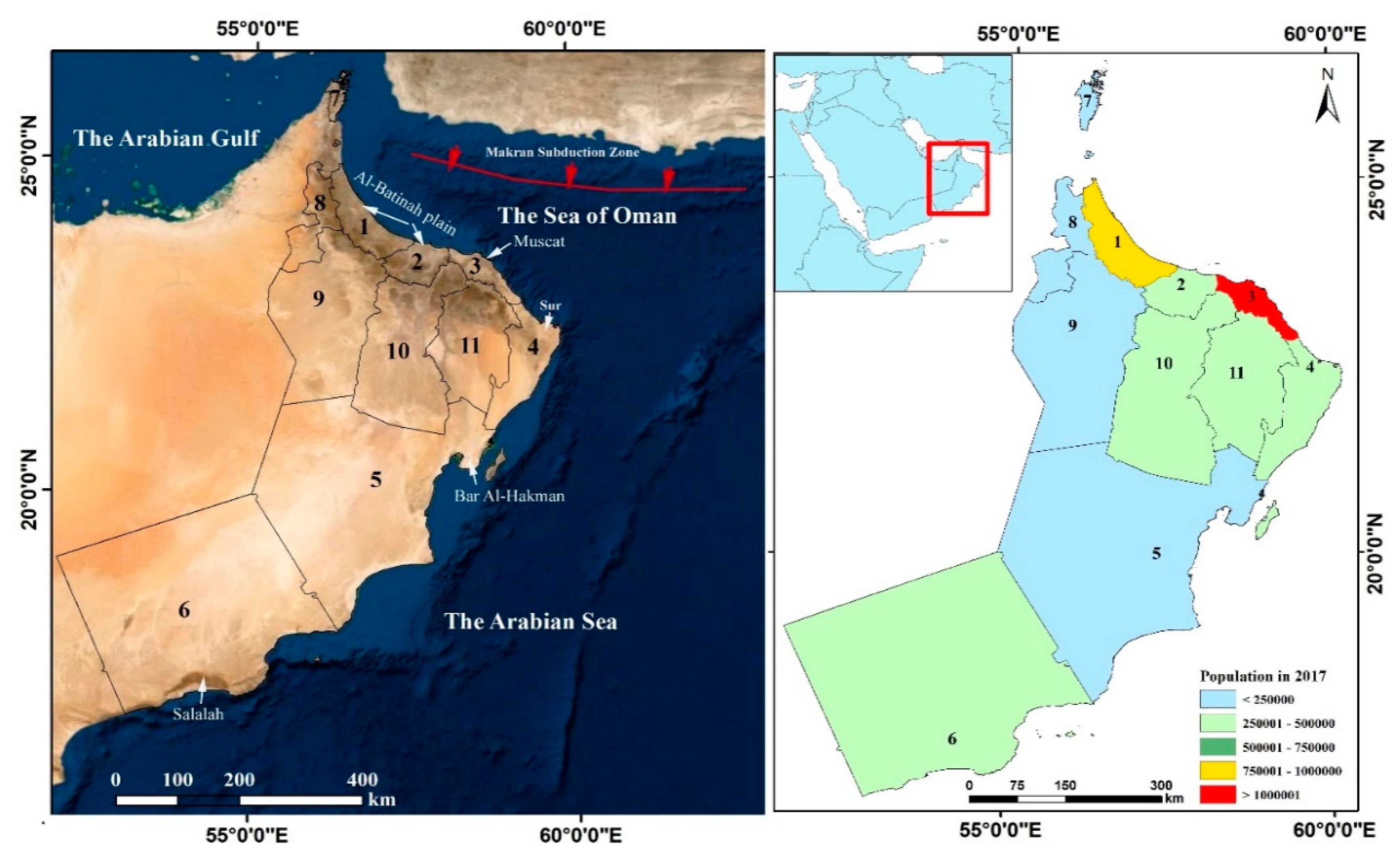
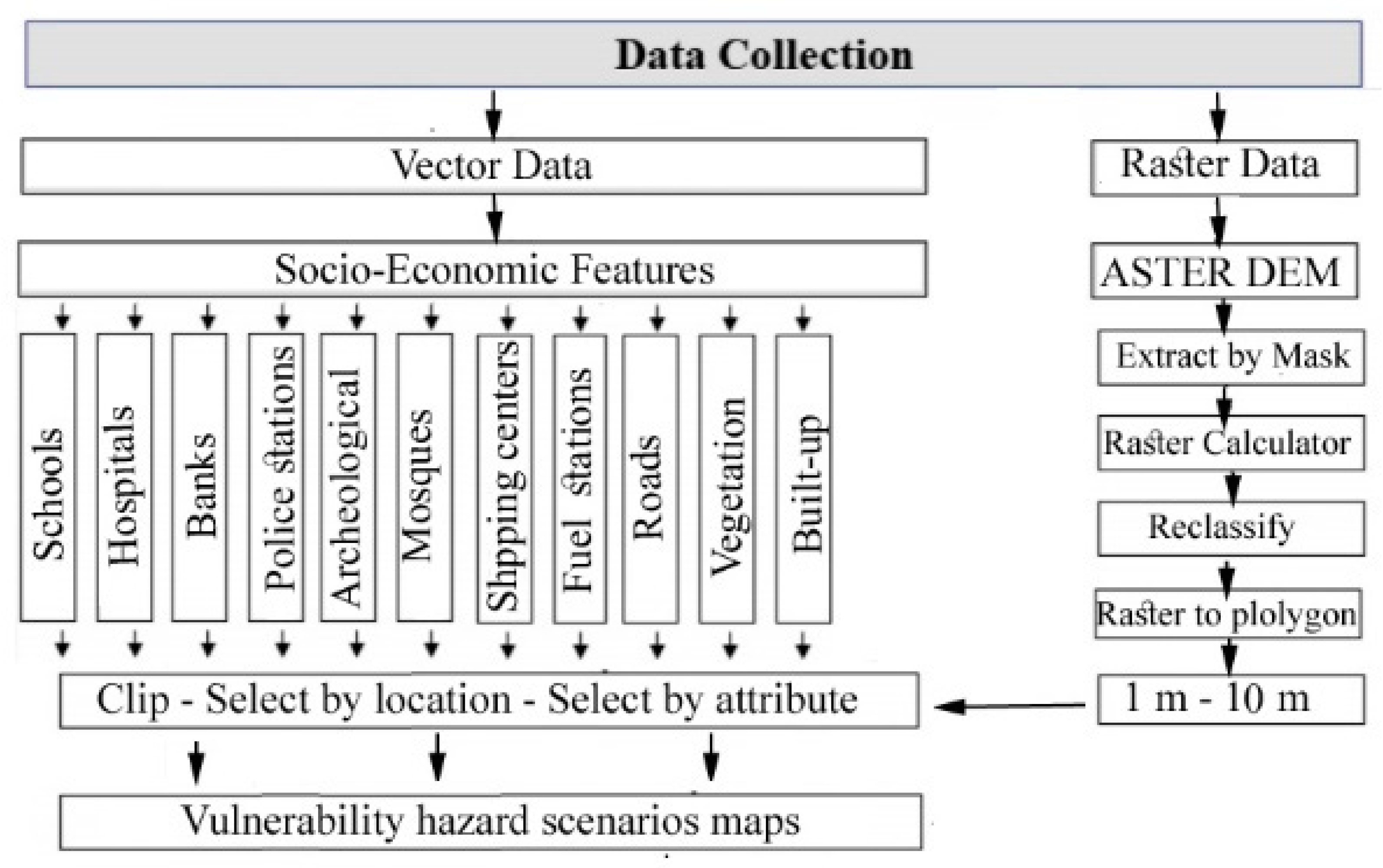
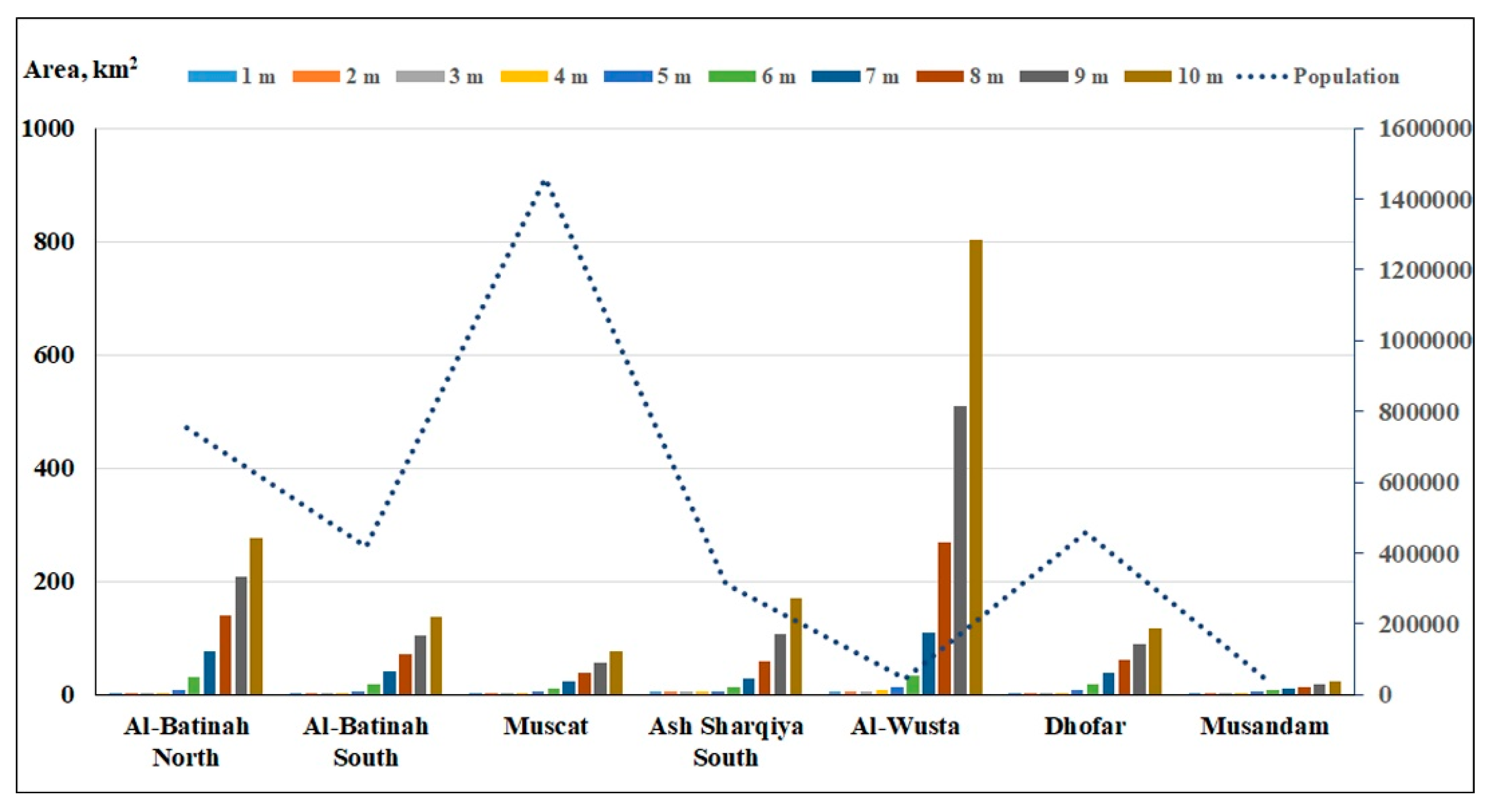

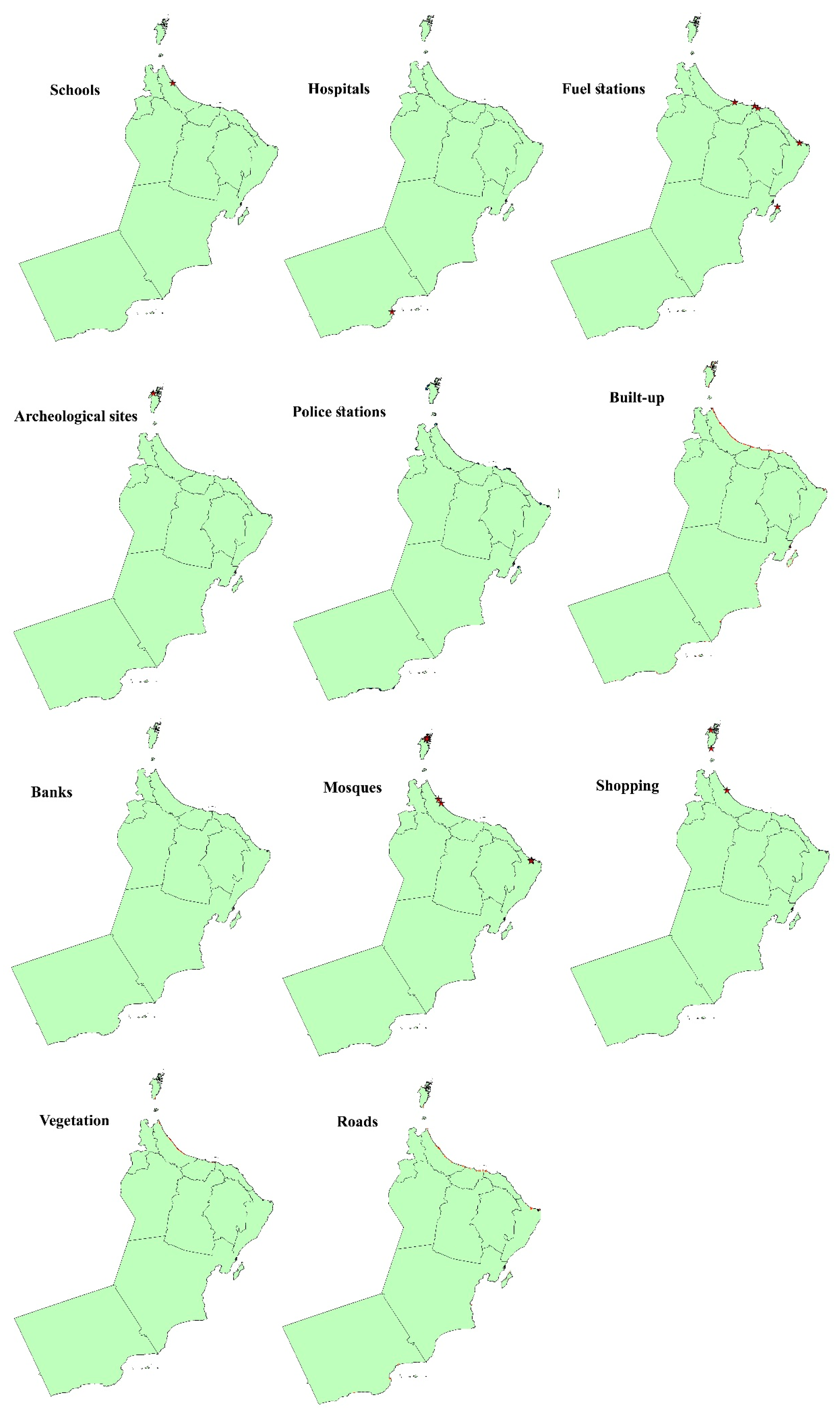
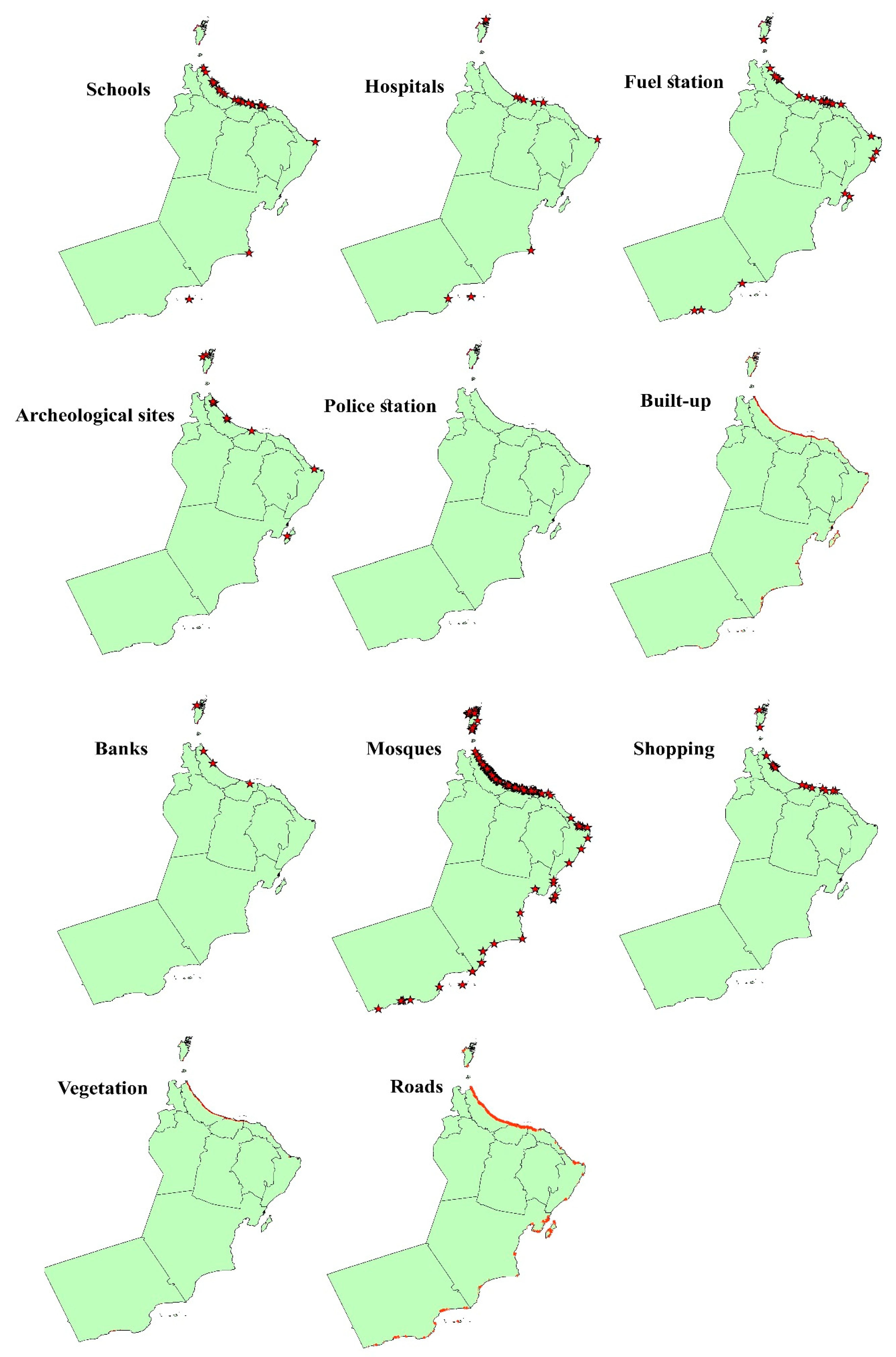
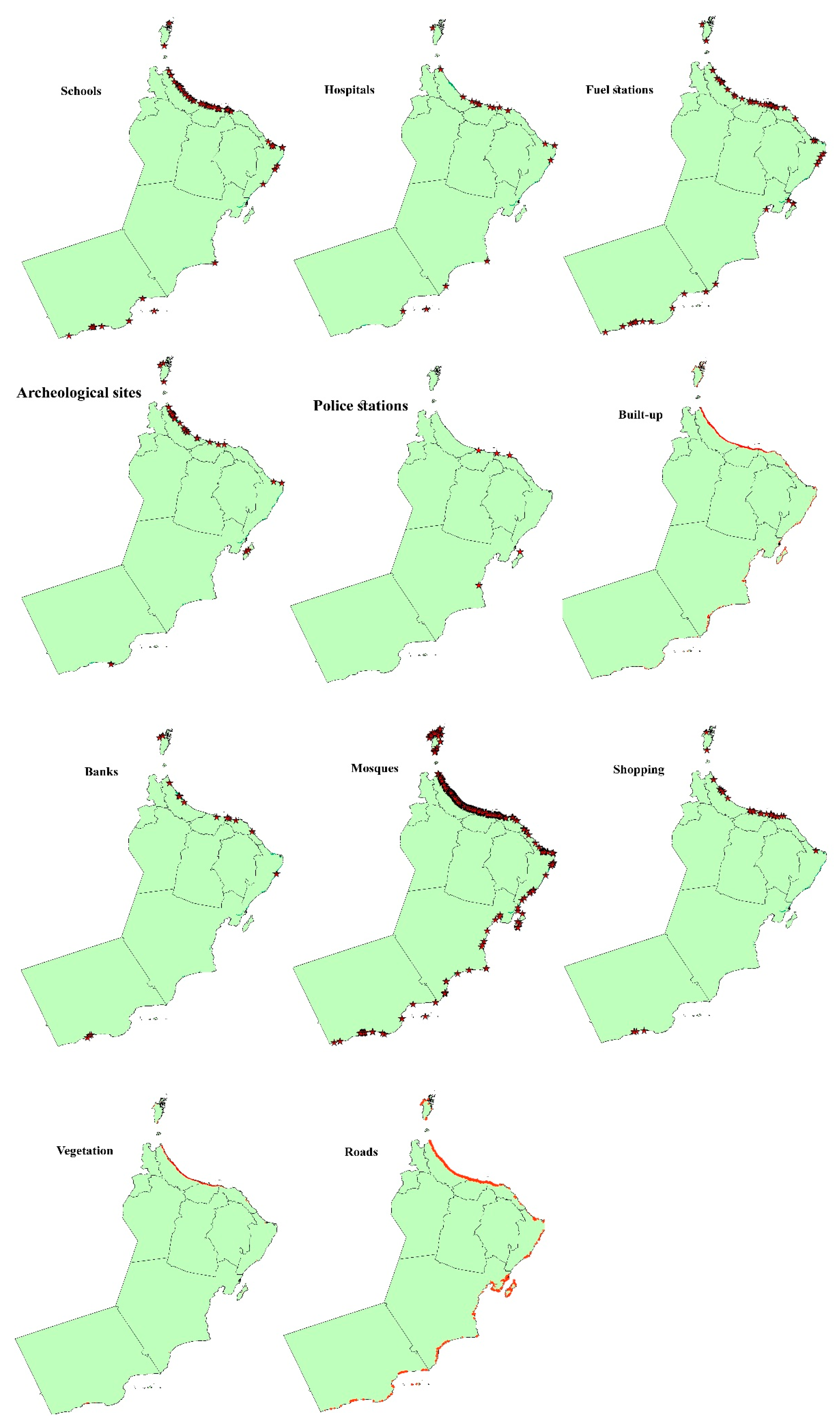
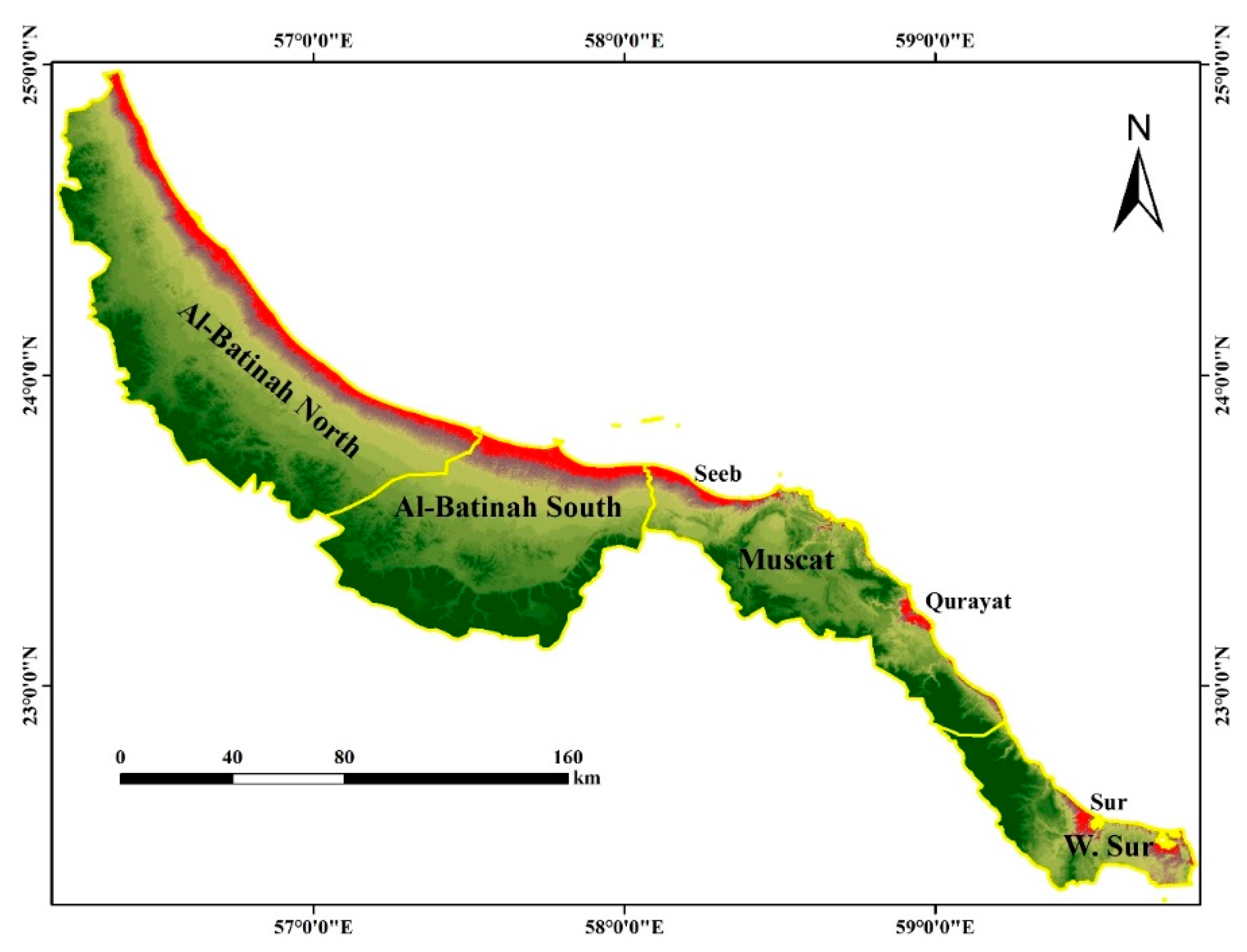
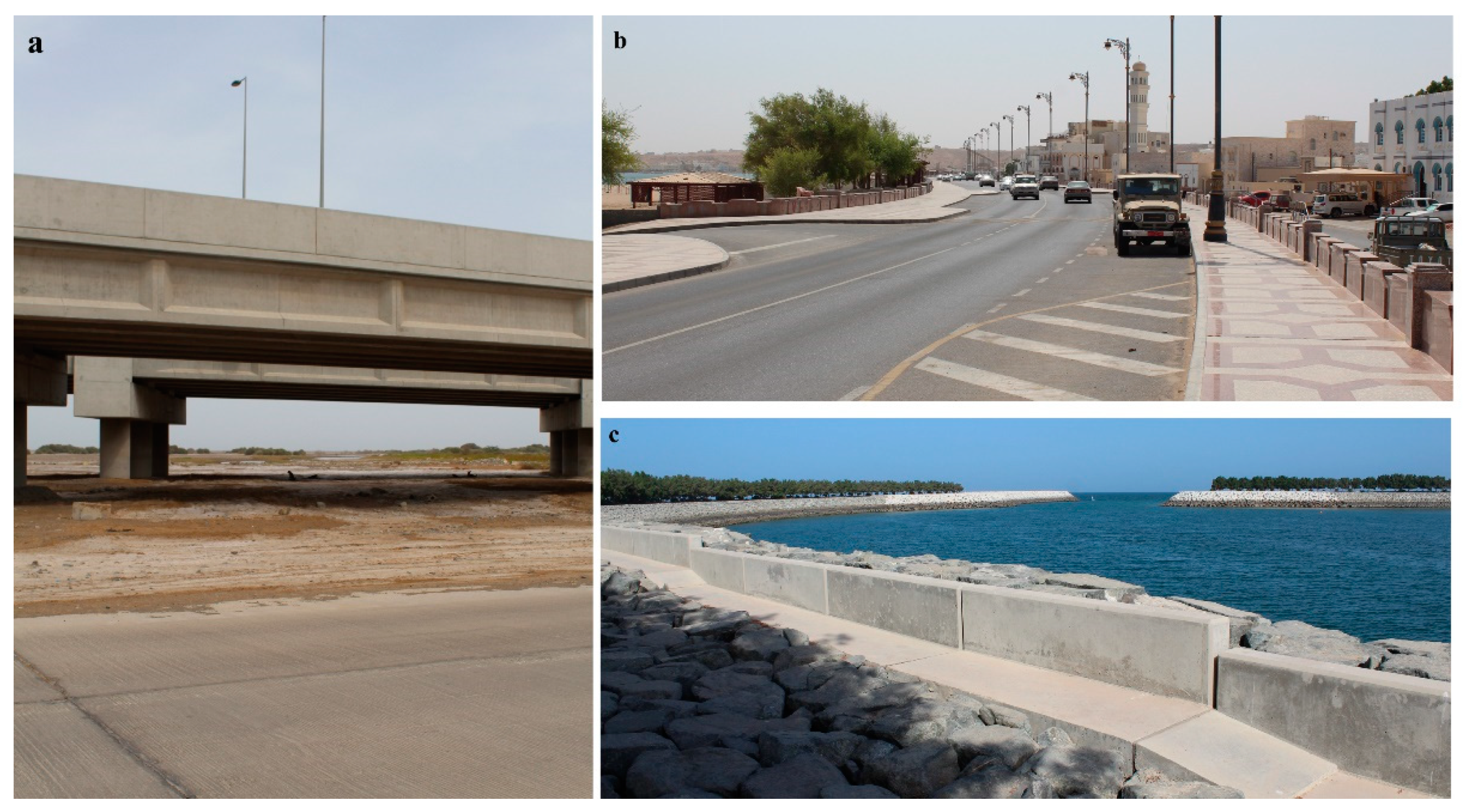
| Infrastructure Feature | Layer | Data Type | Number | Length, km | Area km2 |
|---|---|---|---|---|---|
| Education | Government schools | Point | 1124 | ||
| Private schools | Point | 551 | |||
| Government universities | Point | 1 | |||
| Private universities | Point | 6 | |||
| Health | Health centers | Point | 183 | ||
| Hospitals | Point | 49 | |||
| Security | Police stations | Point | 67 | ||
| Financial | Government banks | Point | 34 | ||
| Private banks | Point | 617 | |||
| Shopping | Malls | Point | 121 | ||
| Market | Point | 203 | |||
| Department stores | Point | 457 | |||
| Religious | Mosques | Point | 12,210 | ||
| Automotive | Fuel stations | Point | 548 | ||
| Historical | Archeological sites | Point | 499 | ||
| Transportation | Expressway | Polyline | 3360 | ||
| Highway | Polyline | 4161 | |||
| Streets | Polyline | 54,968 | |||
| Urban | Built-up | Polygon | 24,512 | ||
| Vegetation | Crops | Polygon | 866 |
| Elevation | Area (km2) | Inundation Area (km2) | % of Oman Area |
|---|---|---|---|
| 1 | 46 | 46 | 0.01 |
| 2 | 48 | 94 | 0.03 |
| 3 | 51 | 144 | 0.05 |
| 4 | 61 | 205 | 0.07 |
| 5 | 97 | 301 | 0.10 |
| 6 | 196 | 497 | 0.16 |
| 7 | 408 | 905 | 0.29 |
| 8 | 750 | 1656 | 0.54 |
| 9 | 1202 | 2858 | 0.93 |
| 10 | 1724 | 4582 | 1.48 |
| Level, m | ||||||||||
|---|---|---|---|---|---|---|---|---|---|---|
| 1 m | 2 m | 3 m | 4 m | 5 m | 6 m | 7 m | 8 m | 9 m | 10 m | |
| Government schools | 0 | 0 | 0 | 0 | 1 | 1 | 8 | 18 | 39 | 63 |
| Private schools | 0 | 0 | 0 | 0 | 0 | 0 | 6 | 9 | 14 | 28 |
| Hospitals | 0 | 0 | 0 | 0 | 0 | 0 | 0 | 0 | 0 | 1 |
| Health centers | 0 | 0 | 0 | 0 | 1 | 3 | 5 | 10 | 12 | 17 |
| Police stations | 0 | 0 | 0 | 0 | 0 | 0 | 0 | 0 | 2 | 5 |
| Government Banks | 0 | 0 | 0 | 0 | 0 | 0 | 0 | 1 | 1 | 1 |
| Priv. Banks | 0 | 0 | 0 | 0 | 1 | 1 | 1 | 5 | 8 | 23 |
| Market | 0 | 0 | 0 | 1 | 2 | 6 | 10 | 13 | 18 | 22 |
| Malls | 0 | 0 | 0 | 0 | 1 | 2 | 2 | 3 | 6 | 9 |
| Stores | 0 | 0 | 0 | 0 | 0 | 0 | 0 | 6 | 7 | 16 |
| Mosques | 8 | 8 | 8 | 10 | 13 | 37 | 106 | 241 | 467 | 703 |
| Fuel stations | 4 | 4 | 4 | 5 | 5 | 9 | 16 | 28 | 45 | 59 |
| Archeological | 0 | 0 | 0 | 0 | 0 | 2 | 8 | 11 | 21 | 35 |
| Expressway, km | 0 | 0 | 0 | 1 | 4 | 13 | 27 | 51 | 85 | 136 |
| Highways, km | 1 | 2 | 2 | 2 | 3 | 8 | 21 | 39 | 66 | 104 |
| Streets, km | 15 | 15 | 15 | 21 | 72 | 276 | 719 | 1360 | 2167 | 3098 |
| Built-up, km2 | 3 | 3 | 3 | 6 | 22 | 69 | 160 | 261 | 439 | 600 |
| Vegetation, km2 | 0 | 0 | 0 | 0 | 1 | 6 | 16 | 32 | 52 | 77 |
| Al-Batinah North | Al-Batinah South | Muscat | Ash Sharqiya South | Al-Wusta | Dhofar | Musandam | Total | |
|---|---|---|---|---|---|---|---|---|
| Population | 0 | 0 | 0 | 0 | 0 | 0 | 0 | 0 |
| Government schools | 0 | 0 | 0 | 0 | 0 | 0 | 0 | 0 |
| Private schools | 0 | 0 | 0 | 0 | 0 | 0 | 0 | 0 |
| Health centers | 0 | 0 | 0 | 0 | 0 | 0 | 0 | 0 |
| Hospitals | 0 | 0 | 0 | 0 | 0 | 0 | 0 | 0 |
| Government banks | 0 | 0 | 0 | 0 | 0 | 0 | 0 | 0 |
| Private banks | 0 | 0 | 0 | 0 | 0 | 0 | 0 | 0 |
| Police station | 0 | 0 | 0 | 0 | 0 | 0 | 0 | 0 |
| Malls | 0 | 0 | 0 | 0 | 0 | 0 | 0 | 0 |
| Market | 0 | 0 | 0 | 0 | 0 | 0 | 0 | 0 |
| Department stores | 0 | 0 | 0 | 0 | 0 | 0 | 0 | 0 |
| Expressway (km) | 0 | 0 | 0 | 0 | 0 | 0 | 0 | 0 |
| Highway (km) | 0 | 0 | 0 | 1 | 0 | 0 | 0 | 1 |
| Streets (km) | 1 | 0 | 1 | 9 | 2 | 1 | 2 | 16 |
| Mosques | 0 | 0 | 0 | 8 | 0 | 0 | 0 | 8 |
| Archeological sites | 0 | 0 | 0 | 0 | 0 | 0 | 0 | 0 |
| Fuel stations | 0 | 0 | 2 | 2 | 0 | 0 | 0 | 4 |
| Built-up area (km2) | 0 | 0 | 2 | 1 | 1 | 0 | 0 | 4 |
| Croplands (km2) | 0 | 0 | 0 | 0 | 0 | 0 | 0 | 0 |
| Al-Batinah North | Al-Batinah South | Muscat | Ash Sharqiya South | Al-Wusta | Dhofar | Musandam | Total | |
|---|---|---|---|---|---|---|---|---|
| Government schools | 1 | 0 | 0 | 0 | 0 | 0 | 0 | 1 |
| Private schools | 0 | 0 | 0 | 0 | 0 | 0 | 0 | 0 |
| Health centers | 0 | 0 | 0 | 0 | 0 | 1 | 0 | 1 |
| Hospitals | 0 | 0 | 0 | 0 | 0 | 0 | 0 | 0 |
| Government banks | 0 | 0 | 0 | 0 | 0 | 0 | 0 | 0 |
| Private banks | 0 | 0 | 0 | 0 | 0 | 0 | 1 | 1 |
| Police station | 0 | 0 | 0 | 0 | 0 | 0 | 0 | 0 |
| Malls | 0 | 0 | 0 | 0 | 0 | 0 | 1 | 1 |
| Market | 1 | 0 | 0 | 0 | 0 | 0 | 1 | 2 |
| Department stores | 0 | 0 | 0 | 0 | 0 | 0 | 0 | 0 |
| Expressway (km) | 4 | 0 | 0 | 0 | 0 | 0 | 0 | 4 |
| Highway (km) | 1 | 0 | 0 | 1 | 0 | 0 | 0 | 2 |
| Streets (km) | 18 | 16 | 9 | 11 | 4 | 7 | 7 | 72 |
| Mosques | 2 | 0 | 0 | 8 | 0 | 0 | 3 | 13 |
| Archeological sites | 0 | 0 | 0 | 0 | 0 | 0 | 0 | 0 |
| Fuel stations | 0 | 1 | 2 | 2 | 0 | 0 | 0 | 5 |
| Built-up area (km2) | 8 | 6 | 4 | 1 | 0 | 1 | 0 | 20 |
| Croplands (km2) | 1 | 1 | 0 | 0 | 0 | 0 | 1 | 3 |
| Al-Batinah North | Al-Batinah South | Muscat | Ash Sharqiya South | Al-Wusta | Dhofar | Musandam | Total | |
|---|---|---|---|---|---|---|---|---|
| Government schools | 8 | 3 | 4 | 1 | 1 | 1 | 0 | 18 |
| Private schools | 5 | 3 | 1 | 0 | 0 | 0 | 0 | 9 |
| Health centers | 2 | 2 | 1 | 1 | 1 | 2 | 1 | 10 |
| Hospitals | 0 | 0 | 0 | 0 | 0 | 0 | 0 | 0 |
| Government banks | 1 | 0 | 0 | 0 | 0 | 0 | 0 | 1 |
| Private banks | 3 | 1 | 0 | 0 | 0 | 0 | 1 | 5 |
| Police station | 0 | 0 | 0 | 0 | 0 | 0 | 0 | 0 |
| Malls | 0 | 0 | 2 | 0 | 0 | 0 | 1 | 3 |
| Market | 9 | 1 | 2 | 0 | 0 | 0 | 1 | 13 |
| Department stores | 3 | 3 | 0 | 0 | 0 | 0 | 0 | 6 |
| Expressway (km) | 50 | 0 | 0 | 0 | 0 | 0 | 0 | 50 |
| Highway (km) | 16 | 0 | 0 | 13 | 4 | 4 | 0 | 39 |
| Streets (km) | 494 | 340 | 165 | 87 | 103 | 108 | 64 | 1360 |
| Mosques | 106 | 42 | 19 | 20 | 10 | 16 | 28 | 241 |
| Archeological sites | 6 | 1 | 0 | 2 | 0 | 0 | 2 | 11 |
| Fuel stations | 8 | 3 | 7 | 4 | 1 | 3 | 2 | 28 |
| Built-up area (km2) | 135 | 62 | 33 | 8 | 14 | 7 | 2 | 261 |
| Croplands (km2) | 26 | 3 | 1 | 1 | 0 | 1 | 1 | 33 |
| Al-Batinah North | Al-Batinah South | Muscat | Ash Sharqiya South | Al-Wusta | Dhofar | Musandam | Total | |
|---|---|---|---|---|---|---|---|---|
| Government schools | 23 | 14 | 9 | 6 | 1 | 7 | 3 | 63 |
| Private schools | 11 | 6 | 4 | 4 | 0 | 3 | 0 | 28 |
| Health centers | 5 | 3 | 2 | 3 | 2 | 2 | 0 | 17 |
| Hospitals | 0 | 0 | 0 | 0 | 0 | 0 | 1 | 1 |
| Government banks | 1 | 0 | 0 | 0 | 0 | 0 | 0 | 1 |
| Private banks | 7 | 1 | 8 | 1 | 0 | 3 | 3 | 23 |
| Police station | 0 | 1 | 2 | 1 | 1 | 0 | 0 | 5 |
| Malls | 0 | 1 | 6 | 0 | 0 | 1 | 1 | 9 |
| Market | 13 | 2 | 4 | 1 | 0 | 1 | 1 | 22 |
| Department stores | 4 | 6 | 4 | 0 | 0 | 2 | 0 | 16 |
| Expressway (km) | 125 | 5 | 0 | 0 | 0 | 6 | 0 | 135 |
| Highway (km) | 43 | 0 | 0 | 32 | 16 | 1 | 0 | 92 |
| Streets (km) | 1149 | 716 | 386 | 237 | 269 | 214 | 127 | 3098 |
| Mosques | 321 | 122 | 61 | 58 | 30 | 40 | 71 | 703 |
| Archeological sites | 23 | 2 | 1 | 5 | 0 | 1 | 3 | 35 |
| Fuel stations | 14 | 7 | 11 | 9 | 3 | 11 | 3 | 58 |
| Built-up area (km2) | 268 | 121 | 69 | 44 | 68 | 16 | 4 | 589 |
| Croplands (km2) | 60 | 11 | 2 | 0 | 1 | 3 | 1 | 78 |
© 2020 by the author. Licensee MDPI, Basel, Switzerland. This article is an open access article distributed under the terms and conditions of the Creative Commons Attribution (CC BY) license (http://creativecommons.org/licenses/by/4.0/).
Share and Cite
Hereher, M.E. Assessment of Infrastructure Vulnerability to Tsunamis upon the Coastal Zone of Oman Using GIS. Geosciences 2020, 10, 175. https://doi.org/10.3390/geosciences10050175
Hereher ME. Assessment of Infrastructure Vulnerability to Tsunamis upon the Coastal Zone of Oman Using GIS. Geosciences. 2020; 10(5):175. https://doi.org/10.3390/geosciences10050175
Chicago/Turabian StyleHereher, Mohamed E. 2020. "Assessment of Infrastructure Vulnerability to Tsunamis upon the Coastal Zone of Oman Using GIS" Geosciences 10, no. 5: 175. https://doi.org/10.3390/geosciences10050175
APA StyleHereher, M. E. (2020). Assessment of Infrastructure Vulnerability to Tsunamis upon the Coastal Zone of Oman Using GIS. Geosciences, 10(5), 175. https://doi.org/10.3390/geosciences10050175





